How would you send help in an emergency if you couldn’t drive or fly?
Imagine you live in Alaska in winter, 1925. There’s a pandemic: children in Nome are getting sick with a disease called diphtheria. Your town needs medicine fast. But the closest medicine is over 600 miles away.
Boats can’t sail there, because the sea is frozen.
Trains can’t move, because ice blocks them.
Planes can’t take off, because they are covered in snow.
There is only one kind of transportation that you know will work. Alaska Natives have been traveling this way for thousands of years:
Sled dogs.

To get the medicine there as fast as possible, 20 mushers (people who run dog teams) and about 150 dogs worked together to travel the 674 miles to Nome. They took turns, like a relay race, taking over when one dog team got tired. Two heroic dogs, Balto and Togo, led the team that brought the serum to Nome.
To celebrate this brave journey
, mushers from all over the world gather yearly to follow Balto’s footsteps. They run a race called the Iditarod–a 1,049 mile race that runs in Alaska from Anchorage to Nome.On this week’s virtual field trip, I’ll share what it’s like to grow up with sled dogs, and you can meet a musher–my mom! It may change your ideas of what dogs and humans can do together
Virtual Field Trip: Friday , February 26 at 10:30 am
Every Friday from 10:30 to 11-ish am, we hold a Zoom call live from the woods for anyone who wants to join. This week, we’ll meet a musher, a person who runs teams of sled dogs.
If you haven’t registered for our field trips before, register here to get the link in your email:
When you register, your registration is good for every Friday.
Teachers: Your class can join these public field trips, or contact us to set up a zoom field trip just for your classroom.
What makes these dogs so good at pulling sleds?
It’s tough to travel by land in the arctic. Animals need to stay very warm and move over deep snow. They have to find food when no plants grow for months.
There are wild animals that can do these things. But dogs were the only Alaskan animal that listen well to humans! Alaska Natives and Siberians were the first to use dogs to pull stuff around. Some people still use them for everyday life today.
So what makes a sled dog different from other dogs?
- They have two layers of fur:
- A short , thick, fuzzy bottom layer close to their skin. This keeps them warm.
- A slick, oiled top layer. This keeps the snow off their bodies.
- They can eat lots of blubber and fat, just like polar bears and in traditional Alaskan diets.
- They have stout, strong bodies.
- They can do well even with low oxygen. That means they can run longer without having to catch their breath!
When you think of a sled dog, you probably picture something like this:
This guy is called a Siberian husky. They have big, thick coats to keep them warm, and are often seen in movies about sled dogs. These pups are really smart and strong. They are still used today for transportation in winter. But they are a little bulky for going fast.
In the actual racing sled dog world, we use dogs called Alaskan Huskies. They are smaller, sleeker, and have bodies shaped for running long distances.

These dogs aren’t technically a “real breed” of dog. Although sled dogs have been distinct for a long time, they also are mutts mixed with other good working dogs, like german shepherds, greyhounds and other huskies. Any smart, strong, and fast dog breeds are probably distant cousins of Alaskan huskies.
How to race a sled dog team
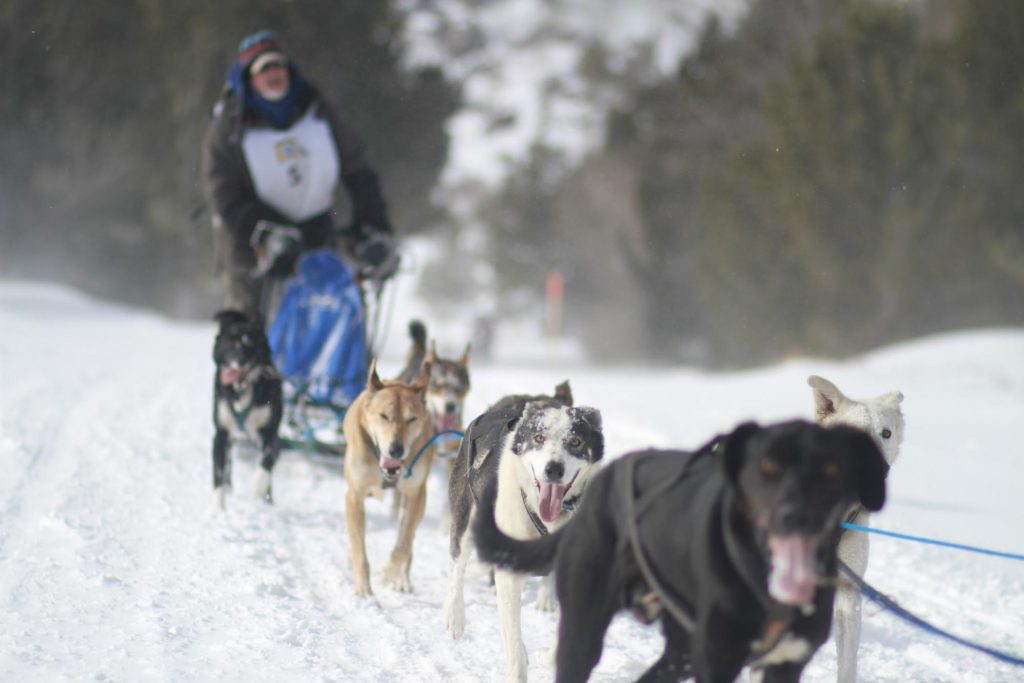
Hooking the dogs up
Look closely at how the dogs are “hooked up” to the sled. They wear harnesses (like some pet dogs wear for clipping to leashes). The harnesses connect them to one long rope by their necks and backs.
The main line is called a “gangline”. The gangline connects to the sled. The “neckline” connects each dog’s neck to the gangline. The line that they pull with their backs is called a “tugline”.
They sometimes have to wear “booties”, which are basically puppy socks
, if there’s a lot of ice or if they are running a very long way. But usually they are happy to have their bare feet in the snow. They have plenty of extra toe fur and special toe fat to protect them.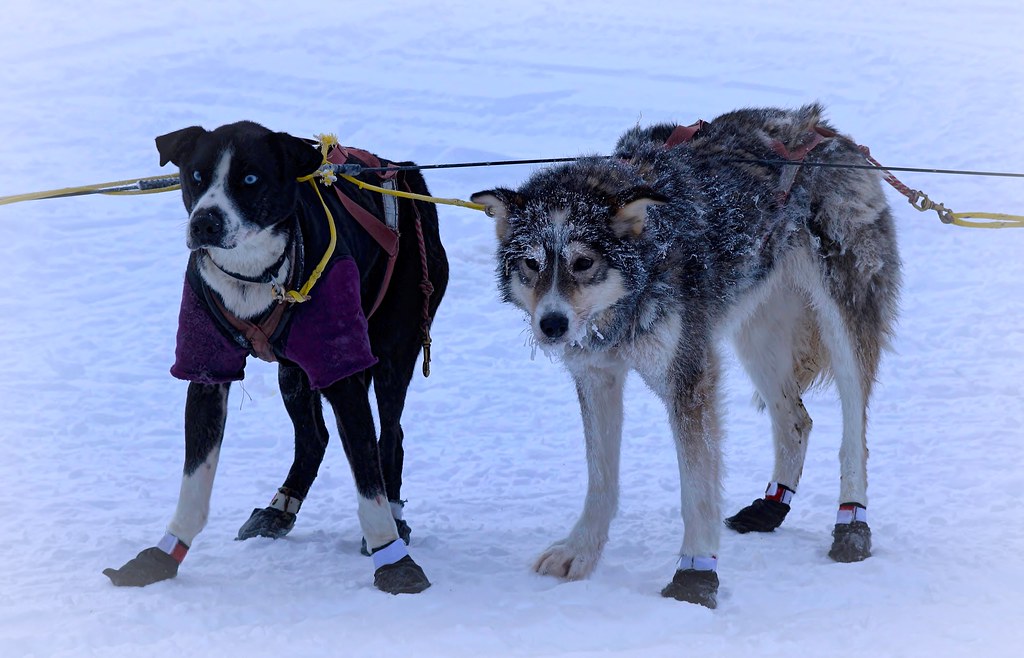
Before you get all the harnesses, lines, and booties on the dogs, you almost always have to tie a “snow hook” to your sled and bury it deep in the snow. This is like an anchor. The dogs get so excited to take off, they run the risk of pulling the sled away without you!
And they’re off!
When you’re on your sled and ready to go, you pull out the big snow hook, bend your knees, and shoot off down the trail.
To race, teams start at different times. They are timed during the race, and given updates at checkpoints. (Can you imagine if it was like a human race, and a bunch of dog teams all took off at the same time? It’d be a huge mess).
The trails are clearly marked. But how do the dogs know which way to go?
The best listeners of your team are placed in the front. They are called “leaders”. They learn terms and phrases from their mushers to know which direction to go in:
- “Gee” (pronounced like “oh geez” without the z) -means to turn right.
- “Haw” means to turn left.
- “Woah” means to slow down and stop.
- “Let’s go” “get up” or “hike” means to get up and start running! (You don’t always need that one. They are usually really excited to do what they love: running really fast).
Next time you are walking with friends, pretend you are a musher: to make each turn, would you shout “gee” or “haw” to your team?
Typically, dog teams run about 9-15mph. That means, when you’re on the sled, you’d better hold on real tight! It may seem like the dogs do all the work. But you have to be very strong and quick to keep track of your team.
When going uphill, you have to step off the sled and run next to the dogs. When going downhill, you have to bend your knees and press on your brakes a little. If you don’t, the dogs could get tangled up in the lines.
You have to use your whole body to turn the sled around curves. Otherwise, you could shoot into a snowbank, like my mom did in this video:
Doing all this in heavy warm gear, while keeping tack of your team and trying to go really fact, is a LOT of work!
At the end of the race
At the end of the race, you unhook and feed your dogs. Then you run inside for cocoa and chili to wait for the awards ceremony. Prizes vary, but the person who comes in last always gets the same thing: a red lantern, in hopes that in the next race you will find your way.
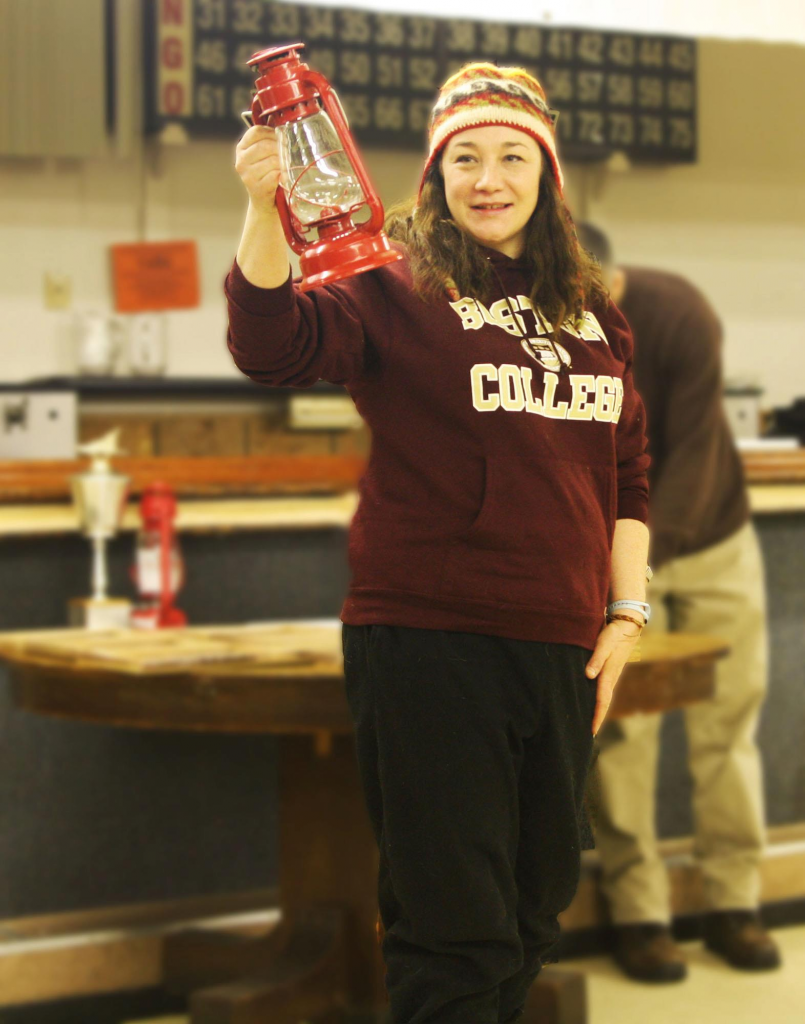
People and their dogs
So why do we do it? Sometimes I think my mother is crazy for investing so much time and energy into this sport. But when you think about it, people have evolved with dogs for a long time. Sledding is a very traditional, natural form of transportation. Mushing lets us preserve this history and relationship with animals.
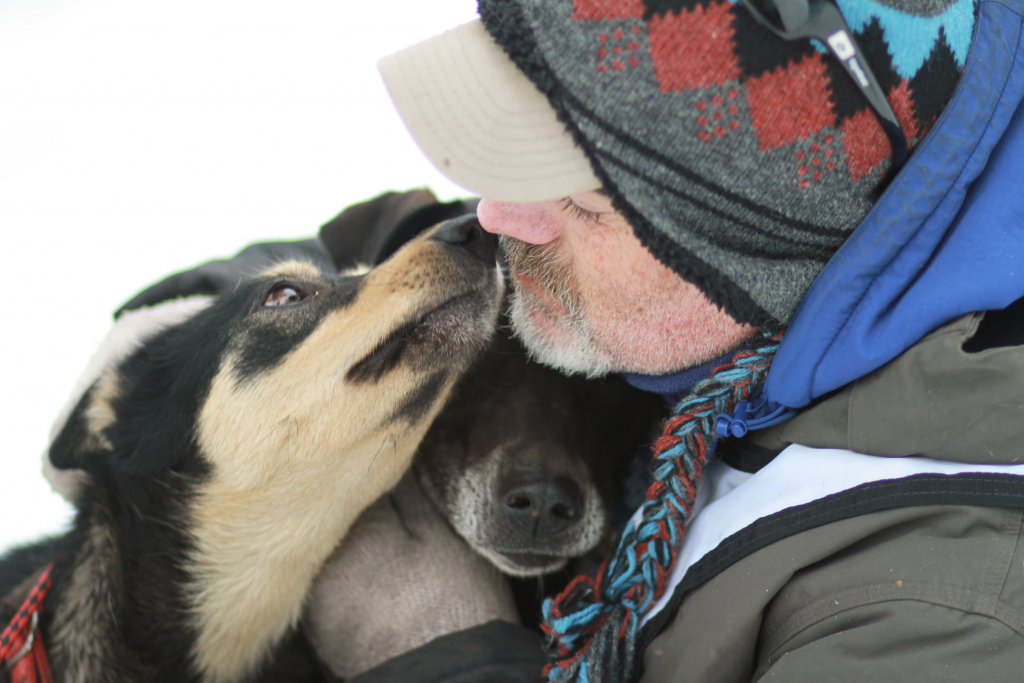
There are a lot of myths about mushing. People worry about the dogs staying outside. Movies and TV shows have displayed mushers whipping, beating, or abusing their dogs in other ways.
As someone who has grown up around mushers and sled dog races, I have to say, this could not be further from the truth. The people who choose to do this sport love their animals dearly (how could you not?). They spend countless hours and resources protecting, feeding, and taking care of them.

These dogs are quite literally built for doing what they do. I like to think of them like very nice coyotes: wily, smart, and loving of the outdoors. Living outside all year round makes them happy and healthy! Playing in the snow in the winter, rolling around in the mud in the summer, tracking down whatever small animals they can find. They love it! (Just a heads up, chickens and sled dogs do not go well together. We have tried many times).
Some people even build really intricate trailers to take their dogs to races, like this one:

There are also “dog boxes”, like this one my mom used to use when she first started out.
Mushers typically have someone with them to help them take care of the dogs. These people are called “handlers”. They are in charge of feeding, scooping poop, and harnessing the dogs before the race. Sound fun?
Sled dog racing is very dependent on teamwork between dogs and people. The mushers have to work with their handlers. The dogs have to work with their mushers.The dogs have to work with each other. Everything depends on a good
, supportive team.Your turn
Your life vs. a sled team
1. If you have a dog at home (or know one), compare it to a sled dog. What kind of fur does your dog have? What does their body make them good at? Could they and other dogs their size pull you on a sled through an icy blizzard? What are their favorite activities?
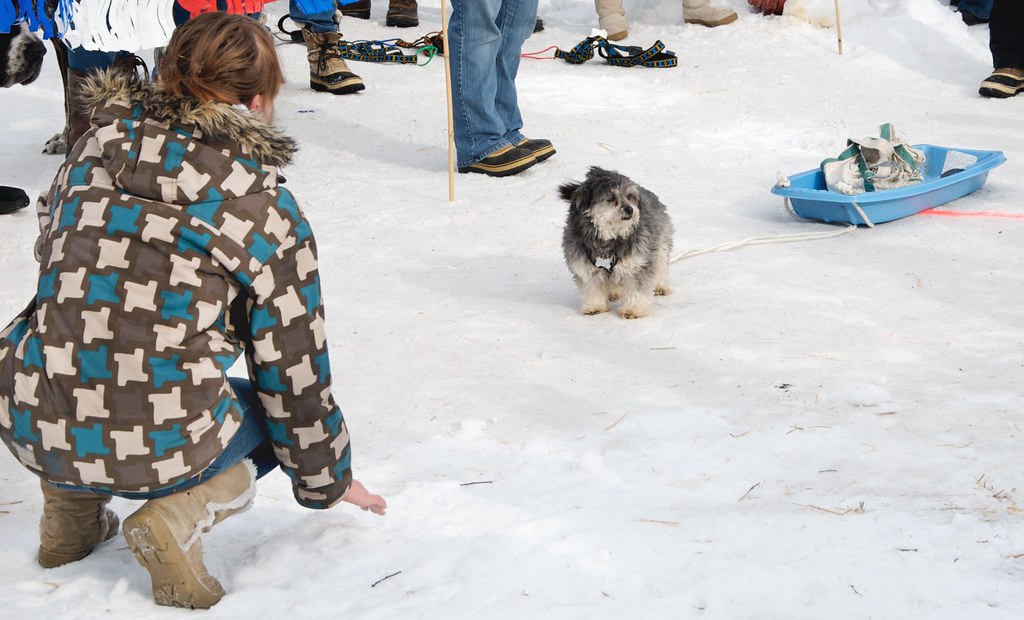
2. Mushers spend a lot of their time training their dogs, figuring out which place in the team works best for them. Each member of the team has a very important role.
If YOU were a sled dog, where do you think you or your family members would fit best? You might be…
- a leader: smart and good at following directions
- one of the hind dogs: strong and steady, pulling most of the weight of the sled
- a middle dog: fast and good at keeping your team on track
3. Think about all the things you would need in a sled. What would happen if you got lost or stranded? What materials do you think you would need to have? We will go over them in the virtual field trip, but try to come up with a good list and compare it to what we talk about.
Working as a team: Sled dog game
Next time you are with your friends, imagine you are a sled dog team. Hold onto a rope together. Work together to move smoothly dow na path or pull something. Where would everyone fit in the team? Are you struggling to keep the rope straight, or are you able to move something?
If you only have two people, make an obstacle course by placing a few harmless objects on the ground. One person is blindfolded. The other is the “musher,” giving instructions. The musher must help the blindfolded person walk past the objects without stepping on them. Try using the words sled dogs hear when they are running: “gee,” “haw,” “woah,” and “let’s go!”
Watch a race
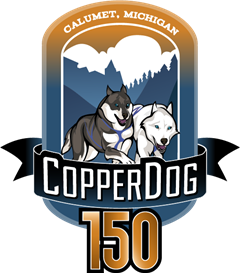
On February 26th, the “Copper Dog” race is happening in the Upper Peninsula of Michigan. We would usually participate in this race! If you’d like to see a race in real time, they have a livestream of the teams taking off. You can watch it here.
One reply on “Sled Dogs: Virtual Field Trip”
This is so cool, Sophie! I love to think about dog scientist,like the pups who specialize in snooping out turtles and mushrooms. Think you guys will ever do a post on dogs in citizen science?
Thanks!